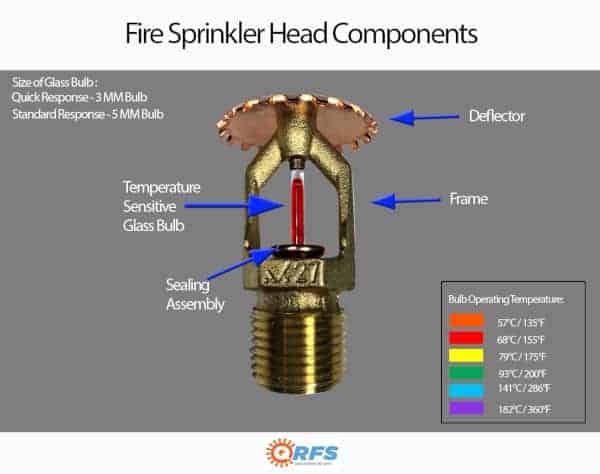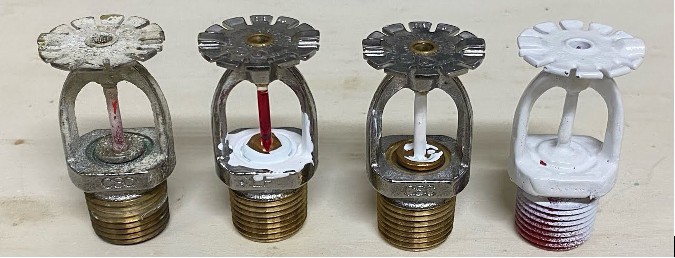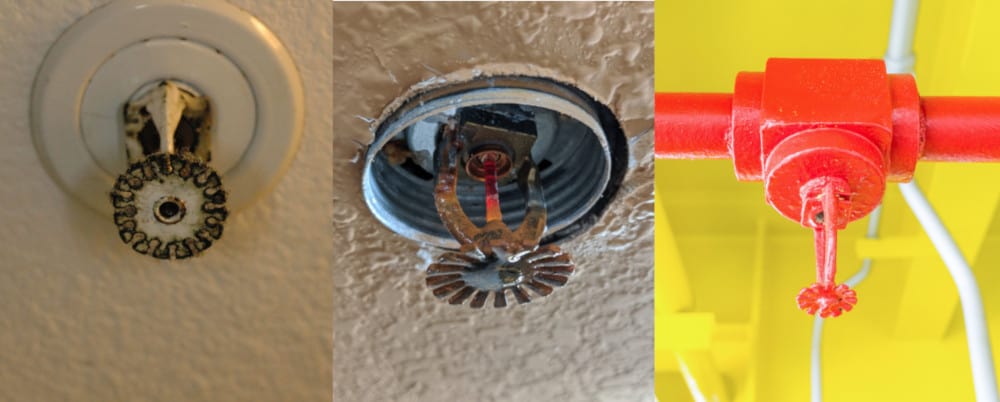How “detrimental to performance” alters the rules for replacing loaded, corroded, and painted fire sprinklers
The last few editions of NFPA 25: Standard for the Inspection, Testing, and Maintenance of Water-Based Fire Protection Systems have important updates and clarifications to the rules for fire sprinkler head replacement.
Specifically, the 2017 and now 2023 editions added qualifiers for three of the six conditions that call for replacing sprinklers: finding corrosion, loading (dust, dirt, and grime), and aftermarket paint on heads. Previously, seeing any amount of these conditions technically required installing a new fire sprinkler. But now, heads must only be replaced if these factors are “detrimental to performance.”
But what does that mean, and who determines it?
Here’s a look at the latest rules and how they represent a significant change in the inspection and maintenance of fire sprinkler systems.
Check out QRFS’s extensive online catalog if you need replacement sprinkler heads. To clean sprinklers loaded with dust in an easy, code-compliant way, use the SprinklerVac. And if you need to paint walls or ceilings, protect your sprinklers with Coverdome paint shields.
Fire sprinkler head replacement and the annual inspection
Before we analyze the new language, let’s look at what various editions of NFPA 25 say in section 5.2.1.
Section 5.2.1.1 in all editions directs that every year, fire sprinklers must be visually inspected from the floor level for signs of damage. Subsequent subsections detail the conditions for replacement. Here’s what the standard used to say in the 2014 edition:
From the 2014 edition of NFPA 25
5.2.1.1.1* Sprinklers shall not show signs of leakage; shall be free of corrosion, foreign materials, paint, and physical damage; and shall be installed in the correct orientation (e.g., upright, pendent, or sidewall).
5.2.1.1.2 Any sprinkler that shows signs of any of the following shall be replaced:
(1) Leakage
(2) *Corrosion
(3) Physical damage
(4) Loss of fluid in the glass bulb heat-responsive element
(5) *Loading
(6) Painting unless painted by the sprinkler manufacturer
Focus on numbers 2, 5, and 6. All three refer to “stuff” on the sprinkler. Corrosion and paint are easy to understand, while loading is a vaguer term that can refer to various substances that cover a sprinkler— dirt, dust, sawdust, grease, cobwebs, etc. In any case, a literal interpretation of the 2014 standard is that finding any corrosion, loading, or aftermarket paint triggers replacement.
But swapping out sprinklers can be a costly and time-consuming process involving draining the system or a portion of it. And not all degrees of corrosion, loading, or aftermarket paint will impair a fire sprinkler’s function. Recognizing these realities, the 2017 edition of NFPA 25 got rid of the old text in section 5.2.1.1.1 and replaced it with this (emphasis added):
From the 2017 edition of NFPA 25
5.2.1.1.1* Any sprinkler that shows signs of any of the following shall be replaced:
(1) Leakage
(2) Corrosion detrimental to sprinkler performance
(3) Physical damage
(4) Loss of fluid in the glass bulb heat-responsive element
(5) Loading detrimental to sprinkler performance
(6) Paint other than that applied by the sprinkler manufacturer
Thus, both the 2017 and 2020 editions of NFPA 25 acknowledged that a little bit of corrosion and loading can be okay, but the paint rule remained ironclad. In addition, the explanatory material in the 2022 edition of NFPA 13: Standard for the Installation of Sprinkler Systems also has strict rules against aftermarket paint:
From the 2022 Edition of NFPA 13
Notes for 7.2.5.2
Sprinklers that have been painted in the field, however slightly (including overspray, as shown in Exhibit 7.7), must not be cleaned of paint and reused. Instead, they must be replaced with new sprinklers.
The words “however slightly” tell the story—no paint tolerated. But now, the latest 2023 edition of NFPA 25 loosens the paint prohibition to match the rules for corrosion and loading (emphasis added):
5.2.1.1.1 (6) Paint, other than that applied by the sprinkler manufacturer, detrimental to sprinkler performance
So, here we are: a little paint, corrosion, and loading can be okay in certain cases. But how much of this material qualifies? And where?
Determining “detrimental to sprinkler performance”
It’s one thing to know that not every painted, corroded, or loaded sprinkler needs to be replaced. It’s another to make the judgment call about when new sprinklers are necessary.
A qualified inspection, testing, and maintenance (ITM) professional must make this determination, subject to approval from the authority having jurisdiction (AHJ). This decision is based on guidance from NFPA 25 and knowledge of how fire sprinklers work.
Let’s recap some basics. A fire sprinkler includes the following key parts:
- A deflector that directs and shapes the spray of water
- A heat-sensitive element, either a soldered link or a liquid-filled glass bulb, that triggers activation
- A sealing assembly with a plug that blocks the water
- A frame made of two “arms” that houses all these components

A sprinkler’s heat-sensitive element holds the sealing assembly in place. When a fire exposes this element to its activation temperate, it breaks, and pressurized water pushes the plug out of its seat. Water flows out of the exposed hole and through the deflector, which shapes and directs the spray to cover an appropriate area.
Based on this mechanism, there are several ways for corrosion, loading, or paint to harm sprinkler performance, as detailed in Annex A.5.2.1.1.1 of the 2023 edition of NFPA 25:
- Insulating the heat-sensitive element and thus delaying or preventing activation
- Blocking up the seal assembly and impeding water from dislodging the plug
- Disrupting the water spray pattern shaped by the sprinkler deflector plate
1. Insulating the heat-sensitive element
This one is pretty straightforward. If something coats any part of the heat-sensing element on a sprinkler, its activation during a fire could be delayed or not happen at all. Paint and corrosive build-up can certainly do this, as can grease, thick dust, and other kinds of loading.
Paint on the cover plate of a concealed sprinkler can also have an insulating effect if it’s on the soldered, meltable link that allows the cover plate to fall off. In addition, paint can seal cover plates to the sprinkler assembly, preventing them from dropping away and exposing the sprinkler. Fortunately, replacing a cover plate easy and inexpensive, especially compared to replacing a sprinkler.

2. Blocking the seal assembly
Anything that prevents water flow by sealing the plug into place or slowing water from pushing it out is a big problem. A layer of paint or thick loading could act like glue, preventing the plug from dislodging. Similarly, corrosion could seal the plug in place, which is one reason some manufacturers, such as Viking, use corrosion-resistant PTFE and stainless steel for the seal assembly.
3. Disrupting the water spray pattern
Sprinkler deflectors direct water over a specific area and help determine the size of water droplets to meet particular fire protection goals, including a minimum discharge density. Corrosion, paint, or thick loading on the deflector plate can affect these spray patterns and characteristics.
What isn’t detrimental to sprinkler performance?
Again, NFPA 25 now acknowledges that not all examples of loading, aftermarket paint, or corrosion are “detrimental to sprinkler performance.” So, when isn’t fire sprinkler head replacement necessary? Section A.5.2.1.1.1 says:
Sprinklers having limited corrosion, loading, or paint in locations on the sprinkler that are not expected to impact the operation or water distribution characteristics can continue to be used.
Essentially, there are “safe zones” on the sprinkler. They include the frame that holds the operating components and the base of the sprinkler. These areas are structural, playing no direct role in heat-sensitive activation or water flow — so a tiny amount of paint, loading, or corrosion shouldn’t affect sprinkler performance.
In addition, there is the matter of degree. NFPA 25 uses the word “limited” to indicate that a little bit of rust, corrosion, or loading is acceptable—depending on the location. So, for example, minor corrosion on a sprinkler frame might not be a big deal. But as that corrosion progresses, the structural integrity of the sprinkler or the components the frame houses may become compromised.
Ultimately, the decision about what’s acceptable should be made by a qualified fire sprinkler professional, subject to approval by the authority having jurisdiction (AHJ; your local fire inspector).
If there is enough doubt about whether some sprinklers need to be replaced, NFPA 25 details procedures for sprinkler testing in section 5.3.1. But if the questions get to that point, an economic decision is in order: it’s probably cheaper and more convenient to just replace affected sprinklers instead of hiring a lab to test them.
Finally, while it’s impossible to clean up corrosion or paint found on sprinklers, there is something that can be done about common loading involving dust. NFPA 25 advises that you can clean dirty sprinklers if you do it without touching them:
In lieu of replacing sprinklers that are loaded with a coating of dust, cleaning sprinklers with compressed air or a vacuum is permitted, provided that the equipment does not touch the sprinkler.
Compressed air has its drawbacks, including some potential to damage a head inadvertently. Instead, using the SprinklerVac attachment with a standard vacuum is the easiest, safest, and touch-free method of cleaning loaded fire sprinklers.
Read our previous blog to learn more about this device and how to clean dirty fire sprinklers.
NFPA 25 has added some discretion to fire sprinkler head replacement
The question of when to replace fire sprinklers looms large in regular system inspection, testing, and maintenance. Because it’s so inconvenient to change out sprinklers, owners and ITM professionals want to know exactly when to put in new ones. Fortunately, NFPA 25 has given ITM professionals and code enforcers more discretion to avoid unnecessary maintenance.
That said, it’s important to remember that local and state governments’ adoption of fire protection codes and standards lag behind NFPA publication schedules. So, your local authorities might not reference the latest edition of NFPA 25 and enforce the older, more stringent rules. In this case, it’s always an option to apprise them of the latest NFPA guidance and make a case for avoiding fire sprinkler head replacement.
Painted fire sprinklers are a pain, so save yourself the compliance headache with Coverdome paint shields. Too late? Check out QRFS’s catalog of replacement sprinkler heads, cover plates, and escutcheons. And remember, cleaning loaded sprinklers is easy with the SprinklerVac.
If you have any questions or need help finding the equipment you need, contact us at (888) 361-6662 or support@qrfs.com.
This blog was originally posted at QRFS.com/blog. If this article helped you, check us out at Facebook.com/QuickResponseFireSupply or on Twitter @QuickResponseFS.





EXCELLENT Article!!!
Very good article.
Great article and very informative. The sprinklervac attachment is mentioned several times as the ideal way to clean the dirty sprinkler heads, but it shows up as DISCONTINUED on your website.
Any other options available for using the vacuum?
Patrick — Unfortunately, yes, the SprinklerVac has been discontinued. The main alternative to cleaning sprinklers without touching them is using a compressed air/air duster, but exercise caution not to damage the temperature-sensitive element. We’ll update this blog and soon publish a new one on this topic! Thanks for reading.
Our HOA is suggesting that sprinkler heads need to be replaced every 10 years. That seems contradictory to what I am reading. Thoughts?
Tammie — The article you read above is concerned with replacing sprinklers that have problems revealed by the annual visual inspection. In addition to that, sprinklers must also be tested every so often, and replaced if the sprinklers in a test sample fail to operate properly. Or, a property could just replace all of them, we suppose.
This blog covers those specific regular testing and/or replacement intervals.
However, a summary: the interval depends on the types of sprinklers and when they were first installed. For example, most (standard response) sprinklers are good to go without testing or replacement for 50 years after initial installation. But once they hit that threshold, a sample of them needs to be tested (and maybe replaced) every 10 years.
Bottom line: if you have a very old system and sprinklers, the 10-year interval might apply. But you have to know the initial installation date and the sprinkler types. A local fire protection pro can take a look and let you know what’s what. Hope that helps and thanks for reading!
Our condo community is having to go through sprinkler head replacements. Unfortunately, the actual inspections took place 6 months ago and the management company is just now mandating this. Most nits that have been flagged are flag as “loaded”. I understand from your article that loaded doesn’t necessarily mean “detrimental” and the actual sprinkler head may not need replacement. I’m hoping the technician will be able to point out and explain to me why it is detrimental.
I write this because one of the first residents sprinkler was flagged as loaded. It was replaced today and he is left with a large square hole in the drywall on his ceiling. Is that the normal way to replace a sprinkler head? Why did they cut the ceiling? He now needs to hire some to fix the ceiling.
Nancy – If the loading is severe enough that it cannot be cleaned without touching the sprinkler (e.g., with a vacuum or air duster), then it is probably moderate to severe and possibly detrimental to sprinkler performance. A qualified onsite inspector must make that judgment.
As for “left with a large square hole in the drywall on his ceiling,” we assume they successfully replaced the sprinkler but cut around it to access it? If the sprinkler is a common recessed sprinkler (recessed into the surface and surrounded by an escutcheon) or concealed sprinkler (completely hidden behind a cover plate), then it’s possible they needed to cut to get to it, but not necessarily. Often, there are tools designed to replace heads that can fit into the appropriate spaces. However, we can’t possibly judge whether this was appropriate or not, as we are not on the scene. If you are concerned about whomever is doing the work, you might contact a local fire protection professional to get their opinion. Thanks for reading.